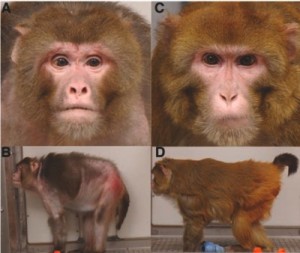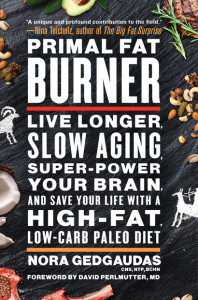Studies involving the use of caloric restriction for significantly improved health and longevity have been ongoing for about the last 75 years. Most of these studies have involved species such as worms, fruit flies, mice and dogs due to their shorter life spans. Although some degree of benefit, often enormous benefit relating to the impact of caloric restriction has been shown in every species studied, some degree of skepticism existed as to whether such dietary restriction would be of similar benefit to primates such as us.
In July of 2009 the eagerly awaited results of a twenty year study on the effects of caloric restriction on primates were finally published in the journal, Science (2009 Jul 10; 325(5937): 201-204).
Two groups of Rhesus monkeys (selected for their strong similarity to us) were studied. One group of Rhesus monkeys were allowed to eat as much as they wanted and the other group was given a sufficiently nutrient dense diet with 30% fewer calories than they would normally consume. Twenty years later only 63% of the monkeys that ate as much as they wanted were still alive. 37% of them had died due to age related causes (heart disease, cancer or diabetes).
And the caloric restriction group?
Fully 87% were still alive and only 13% had died–and of these only 5 of the 14 individuals died of age related causes! The rest died from complications of anesthesia, gastric bloat, endometriosis or injury.
Even the researchers themselves were blown away by these results and confidently speculated that these findings would have considerable implications for combating aging and disease in humans.
Of all monkeys that survived–the remaining two groups of monkeys even looked considerably different from one another. Each group had aged very, very differently.
Throughout their lives the calorically restricted group maintained superior health and aging-related biomarkers in every area: brain health, metabolic health and rate, insulin sensitivity and cardiovascular vitality. The caloric restriction group enjoyed a 3-fold reduction in age-related disease!! Also, they lost fat weight but maintained healthy levels of lean tissue mass. They additionally retained greater brain volume (which normally shrinks with age and glycation) but more than that they retained superior cognitive function. The cardiovascular disease rate of the caloric restricted group was fully half the rate of the control group. 40% of the control group developed diabetes (or pre-diabetes). Not ONE single monkey in the calorically restricted group developed either.
Remarkable.
Photos from the study, shown here, present examples of age-matched individuals from the two groups. The contrast is visually striking. Stunning, even. The caloric restricted monkeys looked almost literally half the age of the controls:
Example of a control group monkey is shown on the left (AB) and a calorically restricted monkey on the right (CD)–both are exactly the same age
The study was designed, of course, well before Cynthia Kenyon’s work was published or anything related to mTOR–both of which have added richly to the understanding behind the mechanisms of just why caloric restriction is so effective, so one can only imagine how much more might have been accomplished with that awareness in mind.
FYI–Among the most common misconceptions about monkeys and apes, incidentally, is that they are vegan animals. They are better adapted to making use of plants in some ways than we are, but they also readily eat the same things we eat. ALL monkeys and apes are known to eat meat–and many even hunt for meat. The one notable exception is the mountain gorilla…and even they get some insects in their diet. Monkeys and apes are omnivores and, like us, will eat whatever might be available to them in their environment. Some even catch and eat fish (crazy, but true)! One of the reasons Rhesus monkeys were selected for this particular study, in fact, is because of their pronounced similarity to us, even in terms of diet. For more reading about this particular aspect of things I can recommend the book, “The Hunting Apes: Meat Eating and the Origins Of Human Behavior” by Craig B. Stanford.
 |
Recent Human Longevity Research
There are actually other recent studies, too, showing significant health benefit where caloric restriction in actual humans is concerned. A newly released study in the Journal of Applied Research, Clinical Experience of a Diet Designed To Reduce Aging (Ron Rosedale, MD, E.C. Westman, MD, MHS, J.P. Konhilas, PhD; Vol 9, No. 4, 2009) demonstrated in the context of an outpatient medical clinic that a diet high in fat (unlimited quantity), adequate in protein (50-80 grams per day) and very low in carbohydrate, with some added multi-vitamin and mineral supplementation (together with 2,000 mg/day L-carnitine, 400 mg alpha lipoic acid, 100 mg CoQ10, and 1 TBSP cod liver oil) led to significant improvement in recognized serum factors related to the aging process (glucose, insulin, leptin and triglycerides). Patients were told to eat when they were hungry. The results also included a significant loss of adipose body weight, a significant reduction in systolic and diastolic blood pressure, and a reduction in levels of leptin, insulin, fasting glucose, and free T3 (with TSH levels and creatinine largely unchanged). Despite the predominance of fat in the diet, serum triglycerides were also greatly reduced.
Another area of human longevity research getting a lot of publicity these days involves manipulating the length of something called “telomeres”. Telomeres are sequences of nucleic acids extending from the ends of chromosomes and act to maintain chromosomal integrity. Every time our cells divide telomeres are shortened, leading to cellular damage and cellular death associated with aging. Scientists (at Geron Corporation) discovered that the key element in rebuilding our disappearing telomeres is the “immortalizing” enzyme telomerase, an enzyme found only in germ cells and cancer cells. Telomerase appears to repair and replace telomeres manipulating the “clocking” mechanism that controls the life span of dividing cells. Drug companies, of course, are looking for ways to enhance telomerase any way they can. In fact, look for up-coming supplements and possibly “life extension” related medications claiming to do just this. What they won’t tell you, however, is that caloric restriction also preserves telomere length. You don’t have to wait for a questionable drug to come out or go broke buying hyped “designer supplements”.
Of course, it’s easy to restrict overall calories with lab animals, as they have no choice in the matter. It is quite another matter to try and restrict overall caloric intake when you’re driving past 15 fast food joints on your way home, are surrounded by constant advertisement and have a refrigerator and cupboards full of food at your ravenous fingertips. UNLESS, of course, you apply the caloric restriction model in a way that does not leave you hungry–which is exactly what Primal Body-Primal Mind tells you how to do. Just follow the simple, most basic dietary guidelines outlined in my book to eat optimally well while feeling fully satisfied, live healthier, longer–and even save some real money along the way!
The most basic guideline to remember is this: greatly restrict or eliminate sugar and starch (preferably eliminating gluten completely), keep your protein intake adequate (roughly the RDA–44-56 g/day or 0.8 g/kg of ideal body weight) amounting to approximately 6-7 ounces of organic grass fed/wild caught meat/seafood total per day, eat as many fibrous “above ground”/non-starchy vegetables and greens as you like and eat as much fat (from fattier cuts of meat or fish, nuts, seeds, avocados, coconut, butter/ghee, olives, olive oil…etc) as you need to satisfy your appetite.
The bottom line here is that natural dietary fat is not at all our enemy–and that in the absence of dietary carbohydrate and with adequate protein can result in a far more satisfying, longer and healthier life overall. Simple, delicious and satisfying. No hunger or feelings of deprivation needed…and all the benefits of supporting a longer and healthier life while saving you money.
If you do nothing from my book other than what was outlined in the paragraph above your health and well being will change remarkably–and chances are you will age much more gracefully and live longer.
And that’s no monkey business.








Wow……….fascinating!!! Those photo’s were priceless. Thank you! Claudia
Good article,
However, primates do not consume high fat and protein diet, they are on high fruit low fat and low protein diet.
The point to this article is not the relative merits of a monkey’s diet, but rather the merits of nutrient dense caloric restriction on primates, in general (where significant dietary variation exists among different primate species). I brought up the hunting and meat eating aspect in the article mainly because it is a common misconception that we are the only meat eating primates. Although the diet I advocate in my book does not embrace the eating of much fruit there is a stress on adequate–and not excessive–protein consumption from complete, nutrient dense and non starchy sources. The aging pathways (and subsequent degeneration) are up-regulated by dietary protein in excess of what is required for maintenance and repair; and dietary sugar and starch—not fat. Dietary sugar and starch are additionally very glycating (especially fructose, in fact) and attract oxidative stress (free radical damage) which further degenerates and compromises us. This is where dietary fat can play a role in supplying quality fat-soluble nutrient density and satiety as a way of implementing a modified caloric restriction approach that is very practical, effective and comfortable to live with. Also, humans were never designed to eat a “low fat” diet.
Again, this study was designed before Cynthia Kenyon’s work relative to insulin’s role in aging and life span was available and before the discovery of the mTOR pathway. One can only speculate how much more might have been accomplished with such a study with those key variables in mind.
For more about all this in detail I refer you to my book, Primal Body-Primal Mind.
Thanks for sharing this. Another motivation for all of us to adopt a primal diet and live a long and healthy life.
Does the benefit from caloric restriction in this monkeys comes solely from lowering their overall carbs intake?
Also, can we describe a primal diet as a kind of caloric restriction? If that’s the case, does consuming more calories negate this effect?
As clearly demonstrated by the award-winning work of Cynthia Kenyon the primary mitigator of aging and lifespan is insulin (i.e., the lower the levels maintained, the better). This said, an even more recently discovered insulin-related pathway, mTOR–which is up-regulated in the presence of dietary protein over and above what is needed for basic maintenance and repair–also plays an important role in aging. Keeping mTOR down-regulated by not exceeding this threshold is what’s important. Both these pathways help explain why caloric restriction shows so much benefit (I go into a lot of detail about this in my book, Primal Body-Primal Mind). It’s not JUST carbs, but excess protein that play a mitigating role. Dietary fat, however, does not appear to be a significant part of this equation. In addition to the mTOR factor, up to 36% of dietary protein in excess of this “protein threshold” can be readily converted to glucose via gluconeogenesis and will be used, stored and directly influence insulin in the same way, so the point is not to eat protein excessively. What is excessive? Recent research presented by Dr. Donald Layman at the recent Nutrition and Metabolism Society Symposium suggests the threshold in a single meal is 30 grams of protein. In my book I suggest sticking to roughly the RDA for protein daily (roughly 44-56 grams per day, total), in preferably divided amounts per meal. This amounts to little more than 6 or 7 ounces per day or about 2 or so ounces per meal. Not a lot–but sufficient for most adult people under most circumstances. You are correct in that exceeding this threshold does negate the positive effects of caloric restriction. Fortunately, the ability to utilize dietary fat allows for much easier implementation of these guidelines and much better satiety at mealtime. Eating non-starchy, fibrous vegetables and greens can easily supply the bulk desired at mealtime without adversely impacting either insulin or mTOR.
In the primate study, the caloric restriction was more general, as Cynthia Kenyon’s research and information about mTOR wasn’t yet available.
In my book, I discuss consuming the kinds of foods our primitive ancestors would have as a place to start. Our physiological design and nutritional requirements have certainly been shaped by these selective pressures. I also apply more currently understood principles related to aging, longevity and what I call “modified caloric restriction” to better optimize health into post-reproductive old age. I do not suggest this is what our ancestors did, because they would not have known to do it. Modern science gives us a leg-up on these things and I make the case for taking advantage of that.
Hi Nora,
Very interesting article. I’m studying clinical nutrition at the moment under Dr Robert Buist. With all of the diet books out there and ones in my possession the low carb, paleo way of eating makes the most sense to me. I have ordered your book and can’t wait to devour it (excuse the pun).
Warm Regards
Interesting info. I think some doctor on the Biosphere project came out with some information on this topic quite a while ago. He even had some recipes, but I couldn’t believe they were actually calorie-restricted as the portion sizes were huge.
This info would be much more useful if someone came out with very detailed meal plans and included amounts, substitutions, and most importantly, PICTURES of what a real meal looked like.